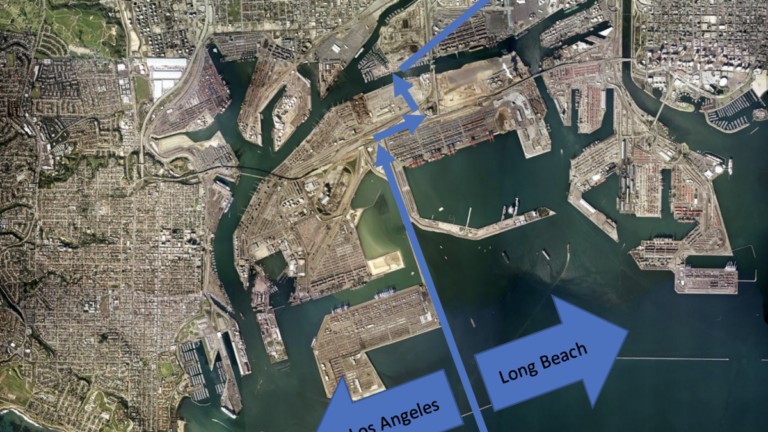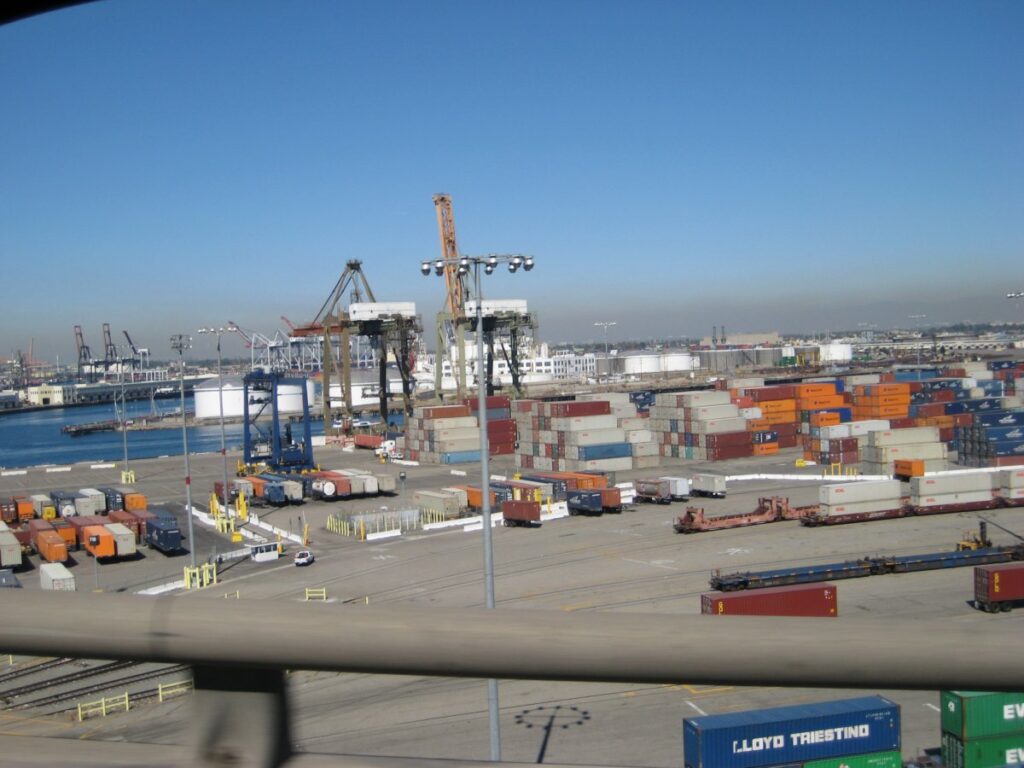
The fine dividing line of the two ports in San Pedro Bay, with the Port of Los Angeles to the left and the Port of Long Beach to the right.
3. The Ports of Los Angeles County in San Pedro Bay
Author: Dr. James A. Fawcett, USC Sea Grant Maritime Policy Specialist/Extension Director (retired)
Media Contact: Leah Shore / lshore@usc.edu / (213)-740-1960
Entrepôt
Entrepôt [pronounced ahn–truh-poh] is of French origin meaning “warehouse” and originates from an old nautical term during the days of sailing ships. In modern-day, it is a city, port, or location to which goods are brought for import and export; a transshipment point between a point of origin and an ultimate destination, often a duty-free port.
Our twin ports of Los Angeles (in San Pedro) and Long Beach may not be duty-free but they are definitely the busiest seaports in the U.S., handling more than 40% of all containerized cargo imported to the nation. From the early 1900s to now, these two ports have evolved as critical resources for a growing region and are the product of political struggles, resource exploitation, and civic pride for the cities of Long Beach and Los Angeles. Throughout this time, they have remained competitors, even though you would be hard-pressed to identify the dividing line between these two maritime powerhouses as they are linked side-by-side and share an island between them.
Port of Long Beach
Beginning with the construction of the San Pedro Breakwater in 1899 to protect the city of San Pedro, the Port of Long Beach was formed in 1911 at the mouth of the Los Angeles River. Its Harbor Commission began developing piers by the middle of the 1920s. With the discovery of oil in the early 20s and the subsequent opening of the giant Wilmington oil field a few miles next door, by the early 1930s, the city had both a need and the resources to advance construction of a large maritime port. Recognizing the strategic location and the growing seaports, in 1932 the U.S. Government purchased more than 100 acres of land on Terminal Island, creating a home port for the U.S. Navy’s Pacific Fleet. The navy continued to manage a large shipyard and naval station on the island until 2001 when it was relinquished to the City of Long Beach and converted into a container terminal.
Port of Los Angeles in San Pedro
Long Beach’s neighbor, the Port of Los Angeles in San Pedro, had an earlier genesis in the 1860s, but shipping was hampered by shallow water and mudflats. It was then that Phineas Banning, who owned an overland transportation company, dredged the harbor 10 feet deep to accommodate vessels at his wharf. Banning’s sons continued the business after his death in 1885, but a competing proposal for a port at Santa Monica by the railroad magnate, Collis P. Huntington, inspired a municipal fight with the City of Los Angeles. This evolved into the Free Harbor Fight in which the City of Los Angeles and San Pedro Harbor prevailed over Huntington and Santa Monica. The U.S. Government constructed the breakwater in 1899, and the City of Los Angeles annexed the City of San Pedro, establishing the Los Angeles Harbor Commission in 1907 to manage the new entity.
Terminal Island: Shared by Two Ports
Subsequent dredging in both ports over the years has expanded the shared Terminal Island on which both seaports have extensive facilities for both bulk and container operations. Dredge material was added to the island, and decade-by-decade it grew from its origin as Rattlesnake Island into the 4.5 square mile (2,850 acre) container terminal powerhouse it is today. Along the way, it hosted tuna canneries, a fishing fleet, a Japanese-American village, and today remains home to the US Coast Guard Station, Los Angeles (Sector LA/LB), and the Terminal Island Federal Correctional Institution.
Cooperation on the Environment
The question is often asked, “do the ports cooperate with one another?” In fact, they are prohibited by U.S. law from cooperating with the exception of environmental matters where they share the water and air. In that regard, they fully cooperated in 2006 to create the Clean Air Action Plan (CAAP) through which they have devised an extensive program to reduce diesel pollution created by the ships, yard equipment, and trucks that transport cargo in and out of the ports. The CAAP was recognized in 2007 with the Environmental Excellence Award by the American Association of Port Authorities.
However, the ports are each owned by their respective cities and generate thousands of jobs in their own cities and throughout the region, as goods are moved to and through this large region of almost 25 million people and to distant destinations, most often Chicago. They are both “landlord” ports, meaning that they lease their land and terminals to private companies, often those owned by the ships that they serve. City employees do not operate the terminals, but they facilitate the operations of the lessee terminal operators and market the services of their ports to the ship operators.
In the U.S., major seaports are often owned by the cities in which they are located, but there are other models: some are owned by the state (Virginia, Delaware, Hawai’i, South Carolina, Georgia), or by a bi-state agreement (Port Authority of New York and New Jersey) and some as both public and private (Richmond, CA). Many of the carriers (shipping lines) serving U.S. seaports are foreign companies, and the terminals in which they berth in our harbors are often leased by their parent companies. Nevertheless, the ownership of the terminal itself (land, facilities, and waterway) is held by the city, state, or combination of the two.
Record-Setting Ports
The Port of Los Angeles is host to seven major container terminals and the Port of Long Beach is host to six. In 2018, the two ports together handled 17,500,000 twenty-foot-equivalent units (TEUs) of containers as the #1 and #2 container ports in the U.S. Their nearest competitor was the combined Port of New York and New Jersey with 7,180,000 TEUs for the year. The two ports together were the 9th busiest port complex in the world in 2019. The twin ports handle 1.3 billion in cargo value every day, over 50% of California’s oil, about 500,000 automobiles, and over a million cruise ship passengers.
Truly, despite their distance from many of us, they are often unrecognized engines of commerce, not only for our region, but for the entire nation, and, arguably, for the world.
